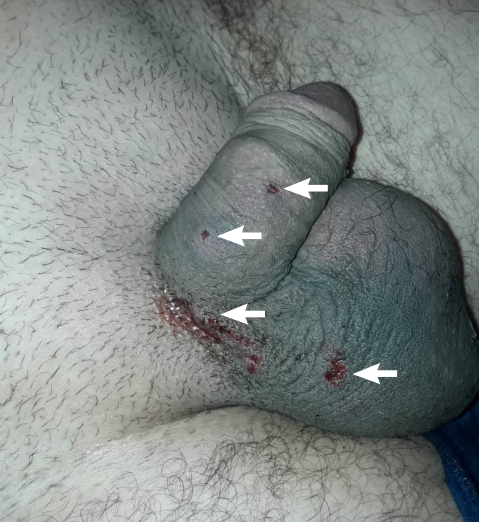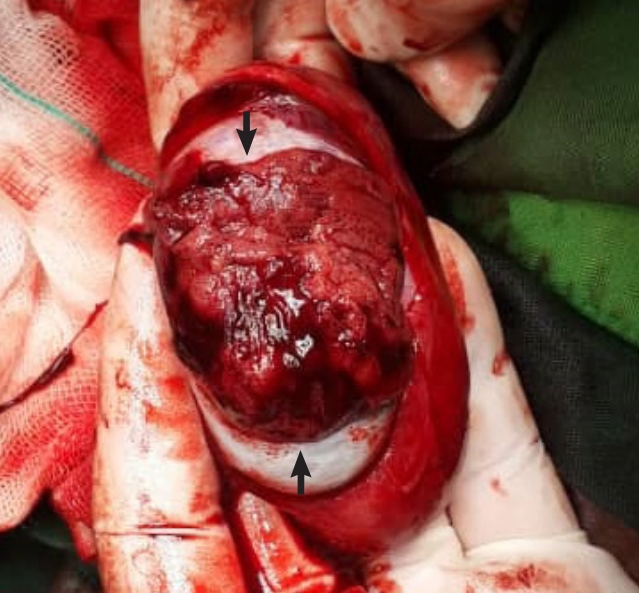INTRODUCTION
A dog bite is not an uncommon situation; however, it is considered to be a rare accident if it occurs in the genital area [1]. Several case reports have discussed the infectious and physical aspects of severe dog bite injuries in the genitalia [2,3]; however, some unresolved issues about the minor injuries still remain. In this case report, we aim to emphasize the importance of attention to minor genitalia injuries caused by dog bites.
CASE REPORT
A 40-year-old male patient who was bitten by a stray dog in the scrotum presented to the emergency department. At initial evaluation, we observed four small lesions on the right side of the genitalia, two spot-sized superficial injuries on the penile skin, a 1-cm injury at the penoscrotal junction, a 5-mm rupture on the slightly larger right hemi-scrotum (Fig. 1). On palpation, the left side was normal while the right side was mildly tender, and larger than the other side. The clinical findings did not reveal much, so we decided to do an ultrasound scan of the scrotum.
An ultrasound examination revealed a normal left testis and a hyperechoic and heterogeneous right testis with a mild hydrocele and a ruptured tunica albuginea (Fig. 2).
Since the tunica albuginea was ruptured, we explored the scrotum, which surprisingly showed a very large tunica albuginea rupture that was incomparable to the skin lesion in addition to hematocele. The right testis was bivalved (Fig. 3). After copious irrigation and repair (Fig. 4), proper antibiotic therapy and tetanus and rabies vaccinations were administered. The patient was followed-up closely and discharged uneventfully.
DISCUSSION
Only two case reports were found in extensive search of PubMed, Embase, and Scopus databases about minor lacerations related to genital dog bites. In one report, a 2-year-old infant with inguinal hernia developed severe peritonitis because the scrotal dog bite appeared to be superficial and small with normal physical exam and was not investigated further; however, the bite was deep to the intestine [1].
In another case report, a 52-year-old man lost his left testis because of a 0.5-cm dog bite on the scrotum. Similarly, the injury was assumed to be skin-deep, small, and unnoticed; however, it was deep to the testis. Necrotized extruded testicular tissue from the ruptured tunica albuginea prompted orchiectomy [2].
In our case, the scrotal lesions were small and appeared to be superficial, but further investigation revealed that they were deep and extensive involving the testis.
The cases with minimal genital lacerations and their outcomes are summarized in Table 1 [1,2]. The jaws of a dog can elicit a pressure of at least 310 kPa, which is much more than that needed to rupture the tunica albuginea [2]. In addition to the testis, other deep parts of the genitalia such as the urethra and corpus cavernosum should be assessed in cases with small penile lacerations using urine analysis, retrograde urethrography or urethroscopy, and penile sonography [4,5].
In conclusion, due to the high power of the dog’s jaws and the puncturing nature of the dog bite, we recommend that even small and apparently superficial genital lacerations caused by dog bites should be examined carefully. An ultrasound examination of the scrotum is recommended for the evaluation of tunica albuginea. A penile ultrasound may be helpful for detecting tunica albuginea injury of the corpus cavernosum; and urine analysis, retrograde urethrography, or urethroscopy may be helpful for urethral assessment. Thus, early diagnosis can decrease the complications of dog bites of the genitalia.

















